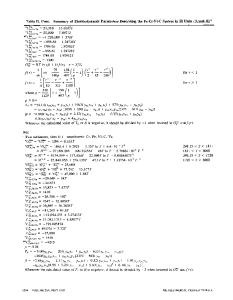A thermodynamic assessment of the Fe-Mn-C system
- PDF / 794,768 Bytes
- 9 Pages / 594 x 774 pts Page_size
- 29 Downloads / 391 Views
I.
INTRODUCTION
M A N G A N E S E is one of the most common alloy elements used in the steel industry. The study of the phase equilibria and thermodynamic properties of the Fe-MnC ternary system is very important for an understanding of the alloy steels. The system, therefore, has been studied experimentally by many investigators over the years. The information on the system available in 1984 was critically reviewed by Rivlin. m The system has also been thermodynamically analyzed several times, mostly at 1273 K and with a limited number of phases, for example, by Nishizawa ]2] and Nishizawa and Uhrenius. ]3] Hillert and Waldenstr6m ]4] analyzed the experimental information on four important phases, ferrite, austenite, cementite, and (Fe, Mn)23C6, in terms of Gibbs energy functions in a wide temperature range. The purpose of the present study was to obtain a selfconsistent description of the thermodynamic properties of the system by assessing all the phase diagram and thermodynamic information available about the system. This was realized by means of thermodynamic models and computerized optimization of the selected experimental information. The thermodynamic description was based upon the recent descriptions of the C, tS] F e , [61 and Mn ]7] unary systems and the Fe-C, tS] Mn-C, I9] and Fe-Mn ]~~ binary systems.
=
cOC
+
+ XcXFeLc,Fe + XCXMnLC,Mn ~t_ XFeXMnLFe,Mn ..~ XC XFeXMn 0 * 1 . 2 * 9 (X C LC,Fe,Mn "b XFe LC,Fe,Mn -[- XMn LC,Fe,Mn)
[1]
The L* parameters are to be evaluated. The other quantities have already been evaluated in the relevant unary and binary systems. The parameters of the other phases will be marked in the same way.
B. Solid Solution Phases The Gibbs energy of the solid solution phases was described with a two-sublattice model, ml (Fe, Mn)a(C, Va)b. The elements Fe and Mn can substitute each other on the metal sublattice and for carbon and vacancies on the interstitial sublattice. For one formula unit of an interstitial solution, the model yields G~ = YFeYVaoave:Va + YFeYc~ o
~
o
+ YMnYVa GMn:Va + YMnYC GMn:C
+ RT[a(yF~ lnyF~ + YMn In yM.) + b ( y c l n y c + YVa In Yva)] "~ E G ~m -~- rngG~m
[2]
where E G ~m =
II.
XF~o GFr + XMno GMn + RTY, Xi In Xi
* Y~eYMn(ycLF~,M,:C + yvaLF~,Mn:Va)
THERMODYNAMIC M O D E L S
All the phases in the ternary system have their prototype in the Mn-C binary system. They are L (liquid), a (bcc, ferrite), 3' (fcc, austenite), e (hcp), a-Mn, fl-Mn, M3C (cementite), M23C6, M5C2, M7C3, and M I s C 4. The term M is used here as an abbreviation for a mixture of Fe and Mn. M15C4 was excluded in the present work by the reasons given in the evaluation of the Mn-C binary system, i9]
A. Liquid Phase The liquid phase was treated with a substitutional solution model yielding the following expression for the molar Gibbs energy: WEIMING HUANG, Graduate Student, is with the Division of Physical Metallurgy, Royal Institute of Technology, S-100 44 Stockholm, Sweden. Manuscript submitted October 10, 1989. METALLURGICALTRANSACTIONSA
+ YcYva(YF~LF~:C,Va+ yM.LMn:C,VR)
Data Loading...











